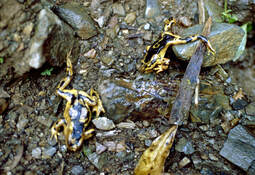
|
A lab collaboration, led by Valia Herrera of the Museo de Historia Natural de la Universidad de San Marcos in Lima, reports the discovery of a new species of harlequin frogs: Atelopus moropukaqumir. The name is made up of a combination of different adjectives from Quechua. Moro means spots. Puka, red. Q’umir, green. The frogs are olive green, their bodies scattered with ruby red dots. Harlequin frogs have suffered greatly during outbreaks of chytridiomycosis, and many species have disappeared and have not been seen for several decades. It was therefore a pleasant surprise to find a population of these frogs in a montane forest, despite the presence of the fungal pathogen.  Many species of Atelopus, especially at mid and high elevations, have vanished over the last three decades. The exact timing of these population declines is difficult to reconstruct, but there are reports of mass die-offs, such as the Atelopus patazensis in the inset photograph in 1999. In the Kosñipata Valley near Manu National Park, the two known species of harlequin frogs, A. cf. erythropus and A. tricolor, have not been seen since the early 2000s, despite frequent surveys at their known breeding creeks. These disappearances coincided with Bd epizootics sweeping through the cloud forests of southern Peru in the early 2000s. The last recorded observation of A. cf. erythropus occurred at Megantoni National Sanctuary in 2004. Two visits to the type locality of A. erythropus near Santo Domingo, Puno, failed to reveal any trace of A. erythropus or the sympatric A. tricolor in 2016 and 2017. In the context of serious population declines, extirpations and possible extinction of montane harlequin frogs, our discovery of a population of harlequin frogs in southern Peru is significant and renews hopes of persistence and recovery of these unique amphibians.
0 Comments
Leave a Reply. |
Archives
June 2024
CATENAZZI LABNews from the lab Categories |

 RSS Feed
RSS Feed